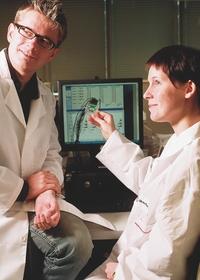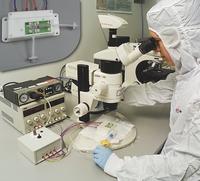Rapid and effective diagnosis of infectious diseases

The Ikerlan technology centre in Arrasate-Mondragón, a member of the IK4 alliance, has been selected to lead the European Optolab Card project. The aim of the project is to develop a rapid and effective diagnostic device for infectious diseases. In fact, infectious diseases are developing more and more due to the greater mobility of carriers.
The device for the project run by Ikerlan will have a portable base and a card that works as a laboratory. This card will detect bacteria caused by infectious diseases, detecting in real time their DNA. To begin with, the card will extract the bacteria that interest in each case. The membrane of these bacteria breaks and makes several copies of the released DNA using biochemical methods. This entire process will be done automatically. Then the portable base will emit a beam of light. In this way an optical signal will be received from the bacteria that contain the sample, and the user, according to the signal received, knows whether the sample is infected or not, that is, whether or not it has disease.
The development of this device involves the Gaiker Technology Centre (IK4) and the Basque Foundation for Innovation+ +Research+Health (BIOEF), as well as technology centres and companies from Germany, Austria, Sweden, Denmark and Poland. The deadline for the project is three years and it is estimated that three more years will be needed to market the new device.
The miniaturized optical laboratory on the card will be the size of a mobile phone and will initially serve to detect salmonellosis, the most prevalent pathogen in the European Union (40.7 people per 100,000 inhabitants). However, the new device will have the ability to detect and separate DNA chains, so that its diagnostic capacity is wide, not limited only to salmonellose. It can also be adapted to detect infectious diseases such as influenza, tuberculosis, hepatitis or AIDS.

Result in 15 minutes
The card has another advantage: It will be the first system to offer a quick diagnosis of an infectious disease for 15 minutes. Currently, conventional analytical methods often have very long protocols, so testing requires longer time, ranging from about 6 to 2 hours. That is, enough time to pollute a whole community or much of the population.
The Lab Card will also have other applications in the future. It can also be used for the detection of genetic diseases, paternity tests, early diagnosis of Parkinson's, Alzheimer's, forensic medicine, etc.
This lab card will probably bring some benefits to the healthcare system. Those responsible for the project consider that there will be fewer incomes, hospital stays will be shortened and the costs associated with diagnosis will be reduced. In addition, they consider that cases of people infected with infectious diseases will decrease.






